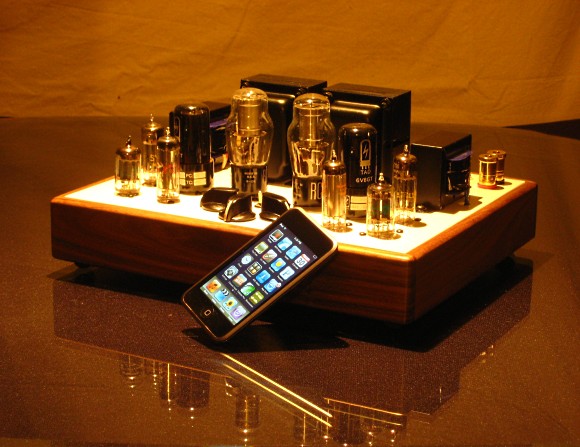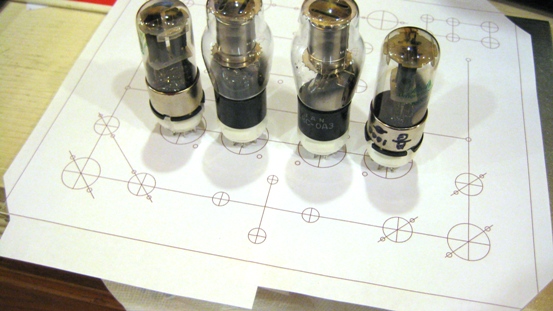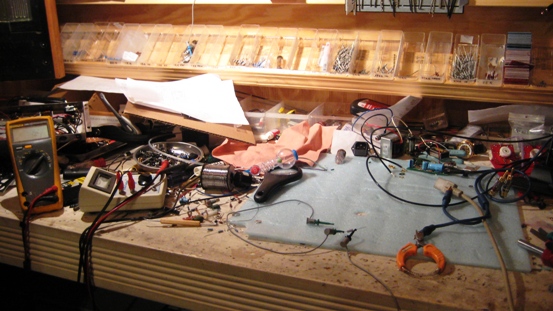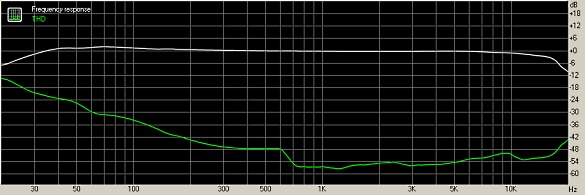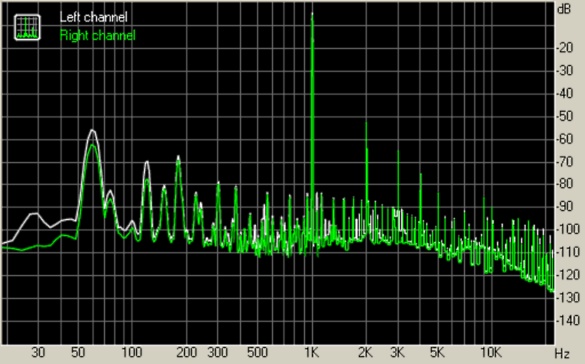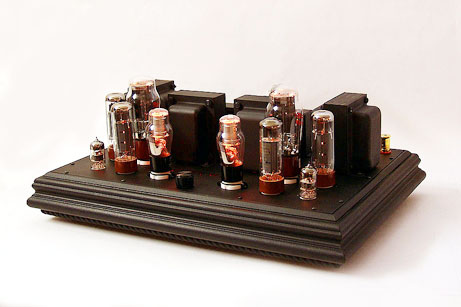|
by THE STORY OF HOW THE AMP CAME TO BE We didn't sit around a table discussing marketing strategies... resulting in the creation of another amp. In fact no Decware amplifier has ever been created for those reasons. Like this one, all were spontaneous ideas that we built for fun. Of course when the results exceed our expectations there is always an overwhelming urge to want to share it! It is at this point when we decide to take one into production. Below is a little story of how this amp came to be... Winter is always a good time for new projects... around here it gets dark at 4:00 P.M. so if not for the total immersion of trying new things we would probably all go crazy. On this particular early November night my creative alter ego and good friend Paul Nibbelin and I were burning the midnight oil building amps. We were trying to shrink the Christmas bulge on the order board when Paul stopped soldering and went to the truck. Soon he slid back through the door (snow) with another ugly little pull-out from a late 50's vintage console or something like that. Cool, another show and tell item, I thought. A tradition we've carried on for 20 years that has created a collection of odd tube amps that could fill the bed of a pick up truck! He set it on the bench and we both stared at it. "Well, what is it?" I finally said. "I dunno", he replied. "I've been using it for my center channel and TV for the past 10 years and figured it would be a good time to check it over." Indeed it had no markings of any kind so we still don't know what company made it. We hooked it up and turned it on and proceeded to crack the top off a fresh cold bottle of organic beer. As the evening progressed we had it dated to between 1958 and 1960. Basically the amp was as old as we were. Then we realized the amp was actually in better shape than we were... and noticed that it appears to have the original tubes. In fact this thing hadn't been touched inside or out as far as we could tell, yet it worked perfectly. The NOS tubes in it still tested strong. Now on my second beer I'm starting to become intrigued with the fact that an amp can be 50 years old, be in service for 12 hours a day for the past 10 years that we know of, and still work with the original tubes. It was a little mono amplifier with a single 6V6 output tube and no feedback with a treble and bass control. We think it was a harmonica amp. Naturally it sounded a bit out there but with the tone controls we were able to keep it from becoming too annoying hooked up to the radio. Having been on for a couple hours I noticed that nothing in this amp gets hot, in fact the power transformer barely gets warm. It was probably that moment when I turned to Paul and said "Why can't we make an amplifier like this... you know something small, light weight that doesn't get hot and lasts forever?" It truly seemed to defy physics from a heat perspective. Well, it sat on the bench hooked to the radio for a couple days until I couldn't stand the sound of it anymore and decided to add some feedback and convert it to a hi-fi amp instead of a musical instrument amp. Took about a 15 minutes and the problem was solved. No longer irritating to listen to. In fact it sounded pretty damn good as most amps do when you can count all the internal parts on your fingers. About this time I was starting to think how nice it would be to have a small little amp like this to set on my desktop and or on my bench. Both places I use my IPod touch to play non-compressed files from our music collection and occasionally stream Internet radio. An application like this would really favor an amplifier that you can easily lift with one hand because A) it was very light and B) the power transformer (or handle) was cool enough to grab and hold. Paul was on the same page needing exactly the same thing for the same reasons. My curiosity with how the amp ran so cool and lasted so long had been satisfied through some reverse engineering and testing. This meant only one thing... we should build ourselves one for Christmas. I suggested it would be fun to see how good we could get one to sound with our parts and techniques and then compare it to the original 1958 unit we modified. We have learned some things in the past 20 years and it would be fun to have a sample of it on our desks. There was also another very significant factor in justifying our little pet project. Everything we've built so far in the Decware line of amplifiers has been based on the European family of output tubes, ie. EL84, EL34, KT88, 6550 etc. This amp would be based on the American family of tubes instead and if designed carefully should be able to accommodate the entire 6V6 family of tubes which include a rather huge variety. With the new family of tubes comes new signatures that could really be fun to manipulate with some tube rolling.
Over the next week or two we figured out the best possible layout and size only to discover the end result was 8-1/2 by 11 inches, the size of a piece of paper... that definitely means it will be small enough for a desk top. We both looked at each other and smiled... and that's were the amp began.
The amplifier is dual mono with a 6V6 output tube wired as a single ended pentode with a tube regulated grid. The input stage consists of a 12AU7 or 12AT7 to drive the 6V6 where both sections of the tube are used for gain. A defeatable tone control consisting of a simple capacitor shunted to ground lives between the stages, and the final stage has a small amount of feedback. It takes advantage of the same output transformers used in our Zen Triode amps. The power transformers on this amp are 50 mils each and use an indirectly heated 6X4 rectifier tube in the mini 7 pin socket. Of course there is one for each side. The 6X4 is a real sleeper of a rectifier tube sounding better than the 5Y3GT, 5U4's we've always used in the past. The amp was built with the same attention to layout as our original Zen Triode amp, using point to point construction with the least amount of nodes possible. The OA3 tube regulation on the output tubes is taken from our Torii MK II amplifier because it works so well to improve linearity. Since the goal with this amp was to see how good we could make it sound we also added OC2 tube regulation for the entire input stage. It is wired on a bypass switch so the amp can operate without it. However the difference it makes in locking everything together sonically is rather amazing so it gets used all of the time. The switch is there because listening to the amp with and without the regulation is truly eye opening and educational. It demonstrates the true value of using tube regulation on the input stage.
In both instances, where the grids of the output tubes and the input stage are regulated, they are not regulated in the typical way. Instead the regulator tube is wired in series with the load. The tube creates a voltage drop and acts as a filter that seems to block much of the nasty harmonics and noise that seeps in from your AC power. Rather than resistors or chokes which provide a direct conductor for the high voltage, the regulator tube creates a condition where all the high voltage must jump between the cathode and plate through a vacume, so hey folks, look no wires! It simply amazes me what doesn't make the jump. In fact even ripple rejection is many times higher that it would be with the equivalent voltage dropping resistors. Off all the tube amplifiers available on the market today, very few use tube voltage regulation so it's realistic to think this amp will be somewhere in the top of pack sonically. NOTE: If you wire the regulator tubes the normal way as a shunt to ground, they actually inject noise that must be later removed.
This amplifier has 3 stages and 2 coupling caps and is blessed with being able to use very small cap values, ie., a 0.1uf and a 0.0022uf which is a huge advantage for keeping the speed up and maintaining a good phase angle. We seriously considered using transformers instead of caps but elected not to because A) good ones are too big and effect the layout in detrimental ways on this amp, B) good ones cost too much, C) I couldn't get the desired drift in the phase angle that I was looking for, or should I say, listening for. Changing the value of the smaller cap alone will yield as many variations on the phase angle as you have time to try, so I played with this for a few weeks. For anyone wondering what exactly the phase angle effects, ... well everything, but the most obvious is sound stage focus and size.
During the day at work we find ourselves listening to the radio and Internet radio such as Pandora etc., and while it sometimes sounds almost hi-fi, most of the time it makes a guy like me suffer. Putting a treble dampening circuit in the amp that is fully adjustable, not in the direct signal path and fully defeatable makes it possible to listen to sub-par sources or recordings with far less distraction. At the same time many high efficiency speakers are fairly tipped up in response, having significantly more treble than bass. If it weren't for this trait everyone would probably love single driver full range speakers but the majority develop a love/hate relationship with them. This amp allows you to damp the top end as much as needed, and on the fly. So it has a dual purpose and I think many people will find it more than valuable.
This is the first amp we've done with more than one gain stage driving the output tubes which means it basically has a preamp built in. This was done for two reasons. A) Since the volume control only gets to the half way point before the amp starts clipping on a 2 volt source, there is a better sense of acceleration. You could think of it as a muscle car with higher compression. B) Using sources like computer sound cards, IPods, and other portable devices means lower than 2 volt sources will be regularly encountered, so the additional gain will restore the drive and weight that these sources typically lack.
Since this is a dual mono amp it is simply two matching mono amplifiers each with their own power supply, on/off switch, and volume control. The only thing that is tied to both amps is the tone control - which is defeatable. Dual volume has two advantages, 1) better stereo separation and 2) It allows you to raise the level of one speaker first and then raise the level of the second to match. It might seem like a less than easy way to adjust volume but unlike a balance control, it gives you deeper control to lock in your sound stage. The amp can be built with a single volume control and even a conventional balance control as a custom option.
Because we could, we added a preamp output that is actually driven off the output transformers. That makes it a low impedance output that is some 20 times lower than most preamps so it is absolutely guaranteed to drive even the most difficult amplifiers and do so with a correct frequency balance / translating to good weight and dynamics. This would be ideal for a sub woofer or a pair of stereo subwoofers, but the exciting application of such an approach is applied to speakers such as open baffles. Those with more than one driver would normally be bi-amped. Biamping always has mixed results because the differences in the two amplifiers used and the preamps ability to control both amps equally. With our approach you can use the Mini Torii SE as your preamp and use it to drive a second amp. This way the second amp closely follows the signature of the Mini Torii and will respond to adjustments in the volume and treble settings of the Mini Torii. To ensure that the signature of the second amp is as close to the first as possible, the even order harmonic signature of the Mini-Torii is embedded into the output signal. This will not only make subwoofers disappear more easily, but anyone with an open baffle or similar high efficiency full range speaker that uses two drivers is certain to have better results when the signature of both amps are matched. This means the second amp can be either tube or solid state.
This amp uses a small amount of feedback on the output stage that makes it ideal for single driver speakers that benefit from a little more control. Remember this amp is a pentode design. Triodes are linear without feedback so why bother with a Pentode amp? Pentodes have more speed and spank than triodes and if properly controlled can come off sounding more like real music via better dynamics and tighter bass control. The operative word there was "properly". It is much easier to get a triode to sound "right" than it is a pentode, however if you're successful the pentode can sound "more right" in many systems. All
this comes together to ideally serve all of the single
driver high efficiency speakers such as Lowther, Fostex
and others by giving them a smooth frequency balance,
an adjustable top end, and flatter more extended bass. SPECIFICATIONS Below is the frequency response of the Mini Torii SE as indicated by the white line, and THD as indicated by the green line. The -3dB point is 28 Hz which is perfect for a lower power amplifier.
The graph below is showing the THD with the first harmonic at -52dB. This also shows us the 60 cycle hum at an impressive -55dB. This puts the dynamic range of this amplifier without distortion at 52dB and with a tolerable amount of harmonic distortion it benches much higher. This is a very a quiet amplifier.
The last graph shows the frequency response double the division as indicated by the white and light blue lines that are on top of each other. The violet line shows the effect of the treble control and the green line just for kicks shows what happens without feedback.
We designed in some flexibility to allow for custom options including but not limited to dual inputs for two sources, EX output transformers for high impendence speakers, different volume control configurations, knob choices, hardwood choices etc.
THE SOUND AND PERFORMANCE As hoped this new amplifier serves a dual purpose. It makes it possible to listen to Internet radio during the day while you work without going mad... and it brings a new light into the listening room when compared to all of the other Decware amps.
Basically we have to look at the sound for each amplifier, since it can be made (like our Zen Triode amp) to drive a dead short OR made to favor high impedance loads depending on which output transformer we use. The original two Mini-Torii's were built like the Zen, and excel into lower impedance loads. When the first one was completed and tested on our 4 ohm DM944 bookshelf speakers were stunned at the performance. It made the speakers get plenty loud, and it made them HIT. The bass was simply breathtaking. However, once placed on my reference 8 ohm corner horns, it clearly struggled, just barely getting the job done. Rather than just decide it needs 4 ohm speakers, we left it on the corner horns for the next several weeks and listened to it anyway. As we did so, I continued to tweak and adjust the circuit until the performance was equal to what we heard on the DM944's. A tremendous amount of progress was made during that stage and the end result was wonderful on both speakers. Basically the higher 8 ohm speakers lowered the power on the amp enough to be barely workable at first. The problem was corrected by raising the overall power level of the amp by fine tuning it's clipping characteristics. In any case this is when we considered the amp finished, built the second one, got identical results, and proceeded to listen to it on the 8 ohm corner horns for many weeks. The third amp built is the one in the picture above, and it was done with the EX transformers to see what would happen. Theoretically it should make another huge improvement on the reference 8 ohm speakers. It took some additional tweaking on this amp because the lower impedance output transformers drop the B+ voltage across the board which changes the signature of the amp. Once completed, this amp was evaluated on the Corner horns for sound quality (and other 8-16 ohm speakers for performance). The result still has me shaking my head. The Corner horns sound better with this amp than any other Decware amp to date, including the Torii Mk II. That brings me to the commonalities between each version of the amp... the bass. Anyone who's owned a good push pull amp and a single-ended amp is well familiar with the advantages one has over the other. I've heard a lot of single ended amps, both large and small that have more than OK bass performance! However, in our own line up of amplifiers, going between the single ended models and our push pull Torii, the Torii has the hit that makes music, especially Rock and Classical fun to listen to. You would think that's largely because of the difference in power between 25 watts and 5 or 6 watts but it's really not the case. It is the signatures of the amps that are responsible. The Mini Torii SE was appropriately named because it has the signature, weight, and hit of it's much larger sibling, the Torii Mk II. Yet the Mini Torii SE is single ended giving it superior low level performance and detail - meaning it will sound more involving at lower volumes. On my corner horns the bass from the Torii MK II is impressive and impossible to ignore, yet on the same speakers the bass from the Mini Torii SE is actually better, tighter, flatter, and equal in amount. Ironically, this magic quality of the Mini Torii SE seems to come almost completely from the OC2 tube voltage regulation applied to the input stage. When it is turned off, the signature of the amp "returns to normal" in that it sounds very much like all of the other Single Ended amps... still very good, but no longer the coherent hit in the bass. When going between say our Zen amp, or Taboo (both single ended) and the Mini Torii during the day with (high bandwidth) Internet radio, the Mini comes off smoother, warmer, fuller making it the new choice for listening at work. The other amps all sound like they have slightly less solid footing, and make a national ordeal of everything that is not perfect with the recording and or source. On its perch as the center piece of the listening room with a really good source, the amp is musically involving. It gives you the low level detail of a great Single Ended amp but with the signature of an equally great push pull - a rare combination that gives you the best of both worlds when efficient speakers are used. All of these observations so far have been made with what will be the stock configuration, a 6V6 output tube and the OA3 regulator tube. Changing to one of the 4 different regulator tube choices will change how the 6V6 (or any other output tube) sounds. Using different output tubes in the Mini Torii SE was exciting because the variety of tubes you can use is so large and the differences in sound were so distinct it was possible to make the amp sound pretty much any way you like. Some combinations were harder sounding which served less efficient speakers well. Some were softer, even pastel sounding with completely different sound stages so it doesn't take long before a tremendous feeling of empowerment comes over you. It really brought the theme of this transparent and flexible little amplifier to be about the tubes themselves. If you thought the amp had a particular signature it was only until you rolled some different tubes in it. One night we stuck a pair of original G.E. 6L6 coke bottle shaped tubes in it from circa 1950's and they sounded just like a classic 300B amp! A final comment about tube rolling... as a designer we can only make an amplifier so good. To push it past this point we would have to voice it in your listening room with your supporting components and with you there, over the course of several weeks getting the bass, midrange, top end, sound stage depth, width, height, rhythm, pace, delicacy, transparency, low or high level detail etc., etc., until it became virtually impossible for anything you buy in the future to sound as good. Well, obviously this can't happen unless you put the designer up for a few weeks and are willing to pay 100 times what the amp actually would have cost. Tube rolling makes it possible (on the right platform) to do just that - voice your own amplifier. The Mini Torii is the right platform. You can invest in and explore the variety of tube choices this amp will run without fear of it blowing up or prematurely burning up your investment. Remember, we have a working prototype that is 50 years old with the original tubes still in good shape and new looking despite the fact they have at least 20,000 hours of idle time on them that we know of. Power of this amp is somewhere between 3 and 6 watts depending on the tubes used and the speakers you connect it to. But wanna have some real fun? Use it to drive the bigger Torii MK II in a bi-amp arrangement.
The
Mini Torii SE's big brother - the Torii MK II.
Link back to the Mini Torii SE product page.
Decware is a trademark of High Fidelity Engineering
Co. |
